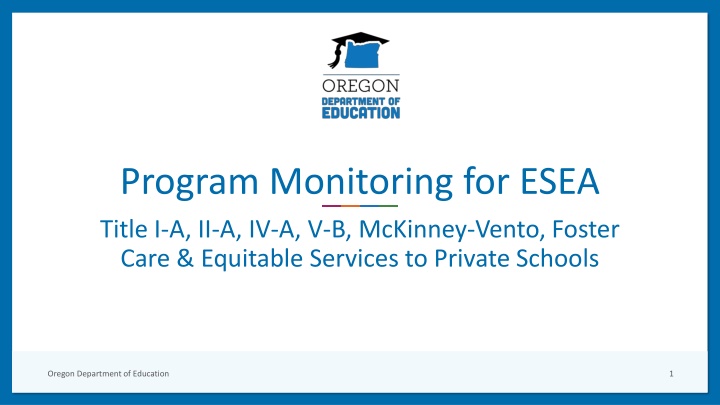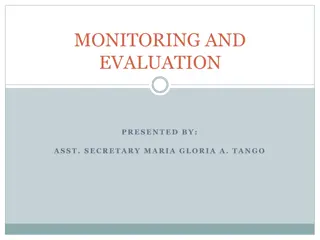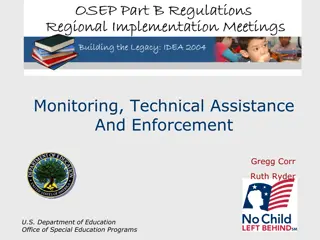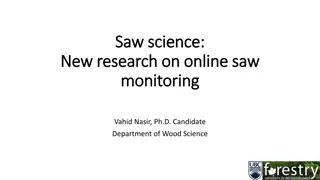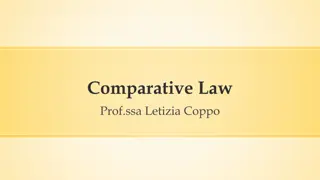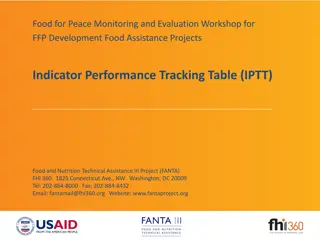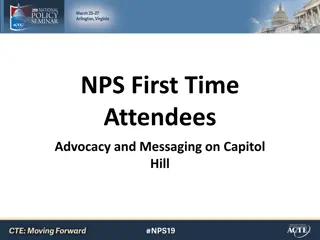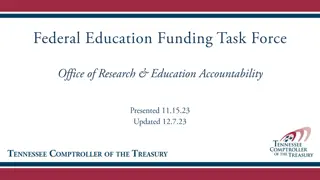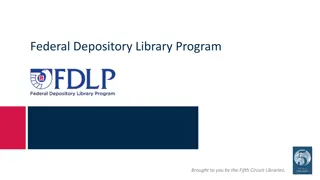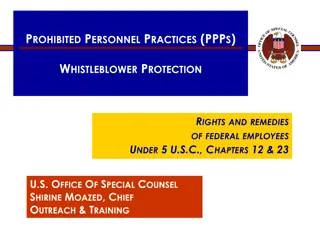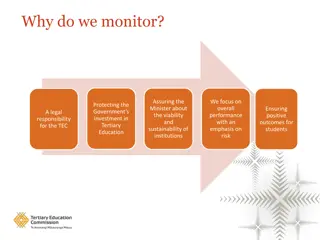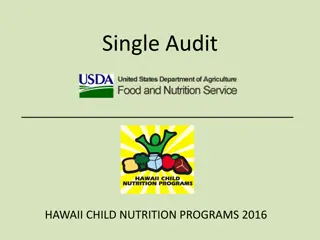Effective Monitoring Practices for Federal Programs in Education
Effective monitoring practices for federal education programs, such as ESEA Title I-A, II-A, IV-A, V-B, McKinney-Vento, Foster Care, and Equitable Services to Private Schools by the Oregon Department of Education. The monitoring process involves desk monitoring and on-site visits to ensure educational equity, compliance with ESSA, and strengthen district systems. Monitoring is an ongoing commitment that includes assessing needs, planning, engaging with families, and demonstrating fiscal responsibility. The desk monitoring process includes risk assessment, preparation, reviewing materials, reporting, and follow-up. Yearly desk monitoring follows a timeline involving entrance meetings, submission of materials, reports development, and exit meetings with districts.
Download Presentation

Please find below an Image/Link to download the presentation.
The content on the website is provided AS IS for your information and personal use only. It may not be sold, licensed, or shared on other websites without obtaining consent from the author.If you encounter any issues during the download, it is possible that the publisher has removed the file from their server.
You are allowed to download the files provided on this website for personal or commercial use, subject to the condition that they are used lawfully. All files are the property of their respective owners.
The content on the website is provided AS IS for your information and personal use only. It may not be sold, licensed, or shared on other websites without obtaining consent from the author.
E N D
Presentation Transcript
Program Monitoring for ESEA Title I-A, II-A, IV-A, V-B, McKinney-Vento, Foster Care & Equitable Services to Private Schools Oregon Department of Education 1
Agenda for Todays Session Monitoring Basics Helping Districts Prepare Reviewing Materials Reporting and Follow-Up Resources & Questions Oregon Department of Education 2
Monitoring Basics Oregon Department of Education 3
Why and How We Monitor Purpose Ensure educational equity Determine compliance with Every Student Succeeds Act (ESSA) Strengthen district systems around federal programs Desk Monitoring vs. On-site Monitoring Desk Monitoring all districts, every 3-6 years depending on risk assessment On-site Monitoring based on results of desk monitoring and need for targeted support
Serving Students is an Ongoing Commitment Districts are continuously: Reviewing data and assessing needs Planning (school plans, program plans) Engaging families and community members Demonstrating fiscal responsibility Monitoring is one way districts and ODE communicate regarding how federal funds are used in this process. Oregon Department of Education 5
Desk Monitoring Process Risk Assessment Helping Districts Prepare Reporting & Follow-Up Reviewing Monitoring Materials Oregon Department of Education 6
Yearly Desk Monitoring Timeline Entrance meetings to help Winter districts prepare Districts submit monitoring materials ODE develops reports and holds Exit meetings with Spring districts ODE conducts Risk Assessment to select districts for monitoring ODE develops reports and holds Exit meetings with Winter districts April-May July-Aug Nov-Dec Feb-March Sept-Oct January April ODE reviews winter monitoring materials Entrance meetings to help Spring districts prepare ODE announces districts to be monitored for Winter and Spring session ODE reviews materials from districts selected for Spring monitoring Oregon Department of Education 7
Risk Assessment Districts selected for monitoring based on the risk assessment are monitored for the following programs: Title I-A Title I-D Title II-A Title IV-A REAP/RLIS McKinney-Vento Private Schools Foster Care Student Achievement District Specific Metrics Last Unresolved Findings Monitoring Cycle Oregon Department of Education 8
Helping Districts Prepare Oregon Department of Education 9
Helping Districts Prepare: Resources ESEA Monitoring Organizational Tool = all the requirements within ESEAfor which districts are responsible Organizational Tool ESEA Monitoring Self-Assessment = tool to help districts examine their practices around federal programs Self-Assessment Submission List = which materials a district must submit as evidence Submission List Oregon Department of Education 10
Self-Assessment Completed by the district team Reflection on district practices compared to monitoring indicators Shared at the Entrance Meeting Oregon Department of Education 11
Purpose of Entrance Meeting For ODE: to learn more about the district s strengths and needs relative to the monitoring indicators; to identify where technical assistance may be needed; to share what materials to submit, including when and how, and to listen. For District : to share the results of the self-assessment; to understand what ODE is monitoring and why; and to get questions answered. Oregon Department of Education 12
Submitting Materials Submission list is the district s guide Materials are submitted electronically Materials due two weeks prior to monitoring Find specific directions in How to submit monitoring materials Oregon Department of Education 13
Reviewing Materials Oregon Department of Education 14
Categories of Monitoring Common Compliance (across programs) Expenditure reports, Time and Effort, inventory Title I-A School-level plans, family engagement, capacity building Title II-A Program implementation and evaluation Title IV-A Consultation, coordination, and evaluation Oregon Department of Education 15
Categories of Monitoring Title V-B (REAP/RLIS) Expenditure reports Equitable Services Identification, consultation and evaluation McKinney-Vento and Foster Care Equitable access and removal of barriers for eligible students Oregon Department of Education 16
Reporting and Follow-up Oregon Department of Education 17
Purpose of the Exit Meeting For ODE: to highlight areas of strength and share findings; to seek clarification through questioning; to outline any additional evidence to be submitted; and to identify required timeline for compliance. For Districts: to provide clarification and context; to understand what additional evidence must be submitted by when; and to get questions answered. Oregon Department of Education 18
Finalizing Compliance Affirmation of the district s efforts to serve students with federal funds ODE staff work with the district to resolve any findings Not being in compliance can impact access to federal funds Oregon Department of Education 19
Remember We don t monitor everything during Desk Monitoring Districts are responsible for ensuring that they are in compliance with ALL indicators listed in the ESEA Monitoring Organizational Tool Oregon Department of Education 20
ODE Monitoring web page Resources District Guide to ESEA Monitoring Self-Assessment for ESEA Monitoring ESEA Monitoring Organizational Tool Submission of Monitoring Materials ESSA Quick Reference Brief for Monitoring Oregon Department of Education 21
Please reach out! Jen Engberg Jennifer.Engberg@ode.oregon.gov Sarah Martin Sarah.Martin@ode.oregon.gov Lisa Plumb Lisa.Plumb@ode.oregon.gov Amy Tidwell amy.tidwell@ode.oregon.gov McKinney- Vento Chris.james@ode.oregon.gov Private Schools Janette.newton@ode.oregon.gov Foster Care Marlie.magill@ode.oregon.gov Oregon Department of Education 22
Jen Engberg Jennifer.engberg@ode.oregon.gov Clackamas, Columbia Gorge, Multnomah and Northwest Regional Sarah Martin sarah.martin@ode.oregon.gov Douglas, Lake, Malheur, South Coast and Southern Oregon Lisa Plumb lisa.plumb@ode.oregon.gov Lane, Linn Benton Lincoln and Willamette Regional Contacts by ESD Amy Tidwell Grant, Harney, High Desert, InterMountain, Jefferson, North Central and Region 18 Oregon Department of Education 23
